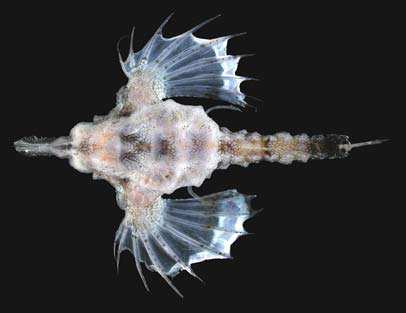PEGASIDAE
Seamoths (Seadragons)
By Ukkrit Satapoomin
 Eurypegasus draconis |
|
Small fishes (to 18 cm); body broad and depressed, completely encased in fused dermal plates; tail encircled by 8-14 bony rings. Mouth small and inferior; toothless; rostrum long and flattened arising from a fusion of the nasals. Gill opening restricted to a small hole on dorsolateral surface behind head; gill filaments lobe-like and with tufts. Dorsal and anal fins short, spineless and usually with 5 soft rays each. Pectoral fins large, wing-like, inserted horizontally, with 9-19 unbranched, soft or spinous soft rays; pectoral-fin rays interconnected by broad, transparent membranes. Pelvic fins thoracic, tentacle-like, with I spine and 2-3 unbranched soft rays. Caudal fin with 8 unbranched rays. Swim bladder absent. Vertebrae 19-22. Color: highly variable, capable of rapid color changes to match substrata; head and body light to dark brown, olive-brown, reddish-brown, or almost black; dorsal and lateral body surface often with reticulations or mottled lines; pectoral fins with broad white margin and small brown spots; unpaired fins with small brown spots in irregular rows. Similar families occurring in the area. Dactylopteridae: head large, snout blunt, body covered with scutelike scales, not encased in fused bony plates, tail not encased in bony rings; pectoral fins extremely large, with 28-37 rays. Remarks. Benthic, found on sand, gravel or muddy bottoms. They apparently "walk" over bottom with the aid of tentacular pelvic fins. Feed on minute zoobenthos with extremely protrusible snout. |

|
|